CHAPTER 21 REVIEW EXERCISES
CONCEPT CHECK EXERCISES
Determine each of the following as being either true or false. If it is false, explain why.
The distance between and is
is a straight line with intercepts (2,0) and (0,3).
The center of the circle is (1, 2).
The directrix of the parabola is the line
The vertices of the ellipse are (2,0) and
The foci of the hyperbola are and (5, 0).
The equation represents a hyperbola.
The equation represents an ellipse.
The rectangular equation represents the same curve as the polar equation
The graph of the polar equation is a straight line.
PRACTICE AND APPLICATIONS
In Exercises 11–22, find the equation of the indicated curve, subject to the given conditions. Sketch each curve.
Straight line: passes through with a slope of 4
Straight line: passes through and
Straight line: perpendicular to and has a y-intercept of
Straight line: parallel to and has an x-intercept of (2, 0)
Circle: concentric with passes through
Circle: tangent to lines and center on line
Parabola: focus vertex (0, 0)
Parabola: vertex (0, 0), passes through (1, 1) and
Ellipse: vertex (10, 0), focus (8, 0), tangent to
Ellipse: center (0, 0), passes through (0, 3) and (2, 1)
Hyperbola: V(0, 13), C(0, 0), conj. axis of 24
Hyperbola: vertex (0, 8), asymptotes
In Exercises 23–36, find the indicated quantities for each of the given equations. Sketch each curve.
center and radius
center and radius
focus and directrix
focus and directrix
vertices and foci
vertices and foci
vertices and foci
vertices and foci
vertex and focus
vertex and directrix
center
center
vertex
center
In Exercises 37–44, plot the given curves in polar coordinates.
In Exercises 45–48, find the polar equation of each of the given rectangular equations.
In Exercises 49–52, find the rectangular equation of each of the given polar equations.
In Exercises 53–58, determine the number of real solutions of the given systems of equations by sketching the indicated curves. (See Section 14.1.)
In Exercises 59–68, view the curves of the given equations on a calculator.
In Exercises 69–74, find the equation of the locus of a point P(x, y) that moves as stated.
Always 4 units from
Passes through with a constant slope of
The sum of its distances from and is 8.
The difference of its distances from and is 4.
Its distance from always equals its distance to
A standard form conic that passes through and (0, 4).
In Exercises 75–120, solve the given problems.
Considering Eq. (21.30) of an ellipse, describe the graph if
Show that the ellipse has the same foci as the hyperbola
The points and (13, x) are collinear. Find x.
For the polar coordinate point find another set of polar coordinates such that and
Find the distance between the polar coordinate points and
Show that the parametric equations and define a hyperbola.
In two ways, show that the line segments joining and (14, 4) form a right triangle.
Find the equation of the circle that passes through and
What type of curve is represented by
For the ellipse in Fig. 21.120, show that the product of the slopes PA and PB is
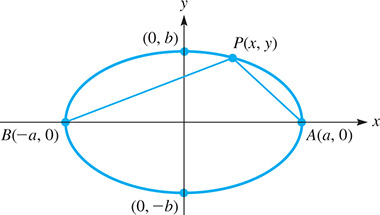
Fig. 21.120
Find the area of the square that can be inscribed in the ellipse
Using a graphing calculator, determine the number of points of intersection of the polar curves and
By means of the definition of a parabola, find the equation of the parabola with focus at (3, 1) and directrix the line Find the same equation by the method of translation of axes.
For what value(s) of k does represent an ellipse with vertices on the y-axis?
The total resistance of two resistances in series in an electric circuit is the sum of the resistances. If a variable resistor R is in series with a resistor, express as a function of R and sketch the graph.
The acceleration of an object is defined as the change in velocity v divided by the corresponding change in time t. Find the equation relating the velocity v and time t for an object for which the acceleration is and when
The velocity v of a crate sliding down a ramp is given by where is the initial velocity, a is the acceleration, and t is the time. If and when find v as a function of t. Sketch the graph.
An airplane touches down when landing at 100 mi/h. Its velocity v while coming to a stop is given by where t is the time in hours. Sketch the graph of v vs. t.
It takes 2.010 kJ of heat to raise the temperature of 1.000 kg of steam by 1.000°C. In a steam generator, a total of y kJ is used to raise the temperature of 50.00 kg of steam from 100°C to T°C. Express y as a function of T and sketch the graph.
The temperature in a certain region is 27°C, and at an altitude of 2500 m above the region it is 12°C. If the equation relating the temperature T and the altitude h is linear, find the equation.
An elliptical tabletop is 4.0 m long and has a 3.0 m by 2.0 m rectangular design inscribed in it lengthwise. See Fig. 21.121. What is the area of the tabletop? (The area of an ellipse is )

Fig. 21.121
An elliptical hot tub is twice as long as it is wide. If its length is 3.6 m, find the distance across the shorter span of the hot tub 1.0 m from the center. See Fig. 21.122.
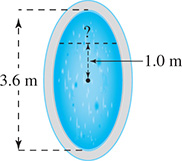
Fig. 21.122
The radar gun on a police helicopter 490 ft above a multilane highway is directed vertically down onto the highway. If the radar gun signal is cone-shaped with a vertex angle of 14°, what area of the highway is covered by the signal?
A circular wind turbine with a diameter of 90 m is attached to the top of a 110-m pole. Find the equation of the circle traced by the tips of the blades if the origin is at the bottom of the pole.
The arch of a small bridge across a stream is parabolic. If, at water level, the span of the arch is 80 ft and the maximum height above water level is 20 ft, what is the equation that represents the arch? Choose the most convenient point for the origin of the coordinate system.
A laser source is 2.00 cm from a spherical surface of radius 3.00 cm, and the laser beam is tangent to the surface. By placing the center of the sphere at the origin, and the source on the positive x-axis, find the equation of the line along which the beam shown in Fig. 21.123 is directed.
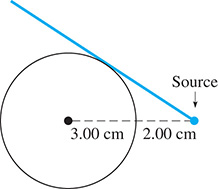
Fig. 21.123
A motorcycle cost $12,000 when new and then depreciated linearly $1250/year for four years. It then further depreciated linearly $1000/year until it had no resale value. Write the equation for the motorcycle’s value V as a function of t and sketch the graph of
The temperature of ocean water does not change with depth very much for about 300 m, and then as depth increases to about 1000 m, it decreases rapidly. Below 1000 m the temperature decreases very slowly with depth. A typical middle latitude approximation would be for the first 300 m of depth, then T decreases to 5°C at 1000 m, and then to 2°C at a depth of 5000 m. Graph T as a function of the depth d, assuming linear changes.
The top horizontal cross section of a dam is parabolic. The open area within this cross section is 80 ft across and 50 ft from front to back. Find the equation of the edge of the open area with the vertex at the origin of the coordinate system and the axis along the x-axis.
The quality factor Q of a series resonant electric circuit with resistance R, inductance L, and capacitance C is given by Sketch the graph of Q and L for a circuit in which and
At very low temperatures, certain metals have an electric resistance of zero. This phenomenon is called superconductivity. A magnetic field also affects the superconductivity. A certain level of magnetic field the threshold field, is related to the thermodynamic temperature T by where and are specifically defined values of magnetic field and temperature. Sketch the graph of vs.
A rectangular parking lot is to have a perimeter of 600 m. Express the area A in terms of the width w and sketch the graph.
The electric power P (in W) supplied by a battery is given by where i is the current (in A). Sketch the graph of P vs. i.
The Colosseum in Rome is in the shape of an ellipse 188 m long and 156 m wide. Find the area of the Colosseum. ( for an ellipse.)
A specialty electronics company makes an ultrasonic device to repel animals. It emits a 20–25 kHz sound (above those heard by people), which is unpleasant to animals. The sound covers an elliptical area starting at the device, with the longest dimension extending 120 ft from the device and the focus of the area 15 ft from the device. Find the area covered by the signal.
A study indicated that the fraction f of cells destroyed by various dosages d of X-rays is given by the graph in Fig. 21.124. Assuming that the curve is a quarter-ellipse, find the equation relating f and d for and
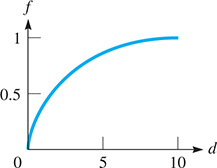
Fig. 21.124
A machine-part designer wishes to make a model for an elliptical cam by placing two pins in a design board, putting a loop of string over the pins, and marking off the outline by keeping the string taut. (Note that the definition of the ellipse is being used.) If the cam is to measure 10 cm by 6 cm, how long should the loop of string be and how far apart should the pins be?
Soon after reaching the vicinity of the moon, Apollo 11 (the first spacecraft to land a man on the moon) went into an elliptical lunar orbit. The closest the craft was to the moon in this orbit was 70 mi, and the farthest it was from the moon was 190 mi. What was the equation of the path if the center of the moon was at one of the foci of the ellipse? Assume that the major axis is along the x-axis and that the center of the ellipse is at the origin. The radius of the moon is 1080 mi.
The vertical cross section of the cooling tower of a nuclear power plant is hyperbolic, as shown in Fig. 21.125. Find the radius r of the smallest circular horizontal cross section.

Fig. 21.125
Tremors from an earthquake are recorded at the California Institute of Technology (Pasadena, California) 36 s before they are recorded at Stanford University (Palo Alto, California). If the seismographs are 510 km apart and the shock waves from the tremors travel at 5.0 km/s, what is the curve on which lies the point where the earthquake occurred?
An electronic instrument located at point P records the sound of a rifle shot and the impact of the bullet striking the target at the same instant. Show that P lies on a branch of a hyperbola.
A 60-ft rope passes over a pulley 10 ft above the ground, and a crate on the ground is attached at one end. The other end of the rope is held at a level of 4 ft above the ground and is drawn away from the pulley. Express the height of the crate over the ground in terms of the distance the person is from directly below the crate. Sketch the graph of distance and height. See Fig. 21.126. (Neglect the thickness of the crate.)
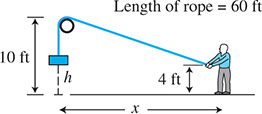
Fig. 21.126
A satellite at an altitude proper to make one revolution per day around the center of Earth will have for an excellent approximation of its projection on Earth of its path the curve where R is the radius of Earth. Sketch the path of the projection.
The vertical cross sections of two pipes as drawn on a drawing board are shown in Fig. 21.127. Find the polar equation of each.
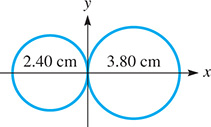
Fig. 21.127
The path of a certain plane is Sketch the path and check it on a calculator.
The sound produced by a jet engine was measured at a distance of 100 m in all directions. The loudness of the sound d (in decibels) was found to be where the 0° line for the angle is directed in front of the engine. Sketch the graph of d vs. in polar coordinates (use d as r).
 Under a force that varies inversely as the square of the distance from an attracting object (such as the sun exerts on Earth), it can be shown that the equation of the path an object follows is given in general by
Under a force that varies inversely as the square of the distance from an attracting object (such as the sun exerts on Earth), it can be shown that the equation of the path an object follows is given in general bywhere a and b are constants for a particular path. First, transform this equation into rectangular coordinates. Then write one or two paragraphs explaining why this equation represents one of the conic sections, depending on the values of a and b. It is through this kind of analysis that we know the paths of the planets and comets are conic sections.
